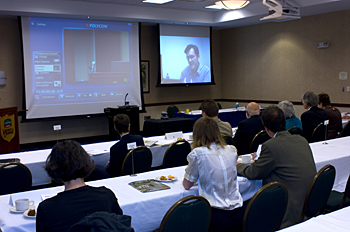
Organized by Ann Ardis, associate dean of the College of Arts and Sciences and professor of English, and Patrick Collier, associate professor of English at Ball State University in Indiana, the conference featured a presentation by Mark Hampton, a professor of history at the University of Lingnan in Hong Kong, via video teleconference, a first for the Courtyard Newark-University of Delaware hotel.
To an audience of more than 50 UD students, faculty and library staff, as well as participants from Temple University, Drew University and University of California at Santa Barbara, 26 scholars from the United States, Canada, Europe and China presented cutting-edge research on the transatlantic print marketplace and on product changes in that marketplace from 1880-1940. An anthology of selected works presented at the conference will be published in 2008.
Topics covered at the symposium included the “new style" in newspaper gossip columns and book reviews; how readers learned to aspire to or disdain the difficulties of modernism in comic cartoons in The New Yorker and Punch; and how readers first encountered modernist masterworks in high-circulation, pulp-fiction formats and in magazines like The Smart Set, which deliberately undermined cultural divides.
At the symposium, literary critics, media studies scholars and historians explored modernism's first emergence in periodicals such as The Freewoman and The Smart Set and investigated material changes in publishing brought about by the emergence of new, mass-produced, printed materials such as national newspapers, political publications, mass-market magazines, paperback books and other new media forms in Britain and the U.S. from 1880-1940.
Ardis said she and Collier decided to organize a symposium after the success of their smaller session on literary modernism and periodicals at a meeting of the Modernist Studies Association in 2005.
She and Collier worked with Paul Rickards, manager of UD's IT-University Media Services, and Bill Sullivan, supplemental faculty member in the Department of Hotel, Restaurant and Institutional Management, and managing director of the Courtyard Newark-University of Delaware to create the teleconference for Hampton. “Several studios in Pearson Hall are outfitted for two-way teleconferencing, but this was the very first time the UD Marriott used its equipment,” Ardis said. “Even though Hampton was 12 hours ahead of us, so his session started at 8:30 p.m. Hong Kong time, there was very little delay in the audio, and he was able to see and hear the speakers, the audience and view the PowerPoint presentations.”
Ardis said the turn of the 20th century was a period of great change in American and British book, newspaper and periodical publishing. More books, newspapers and magazines were being published in innovative venues and formats and were reaching a wider readership, she said, adding that lot of research is currently being conducted on the period.
“This symposium was an opportunity to assemble a research group of historians, design historians, literary scholars and media specialists who have been addressing issues related to these changes in print media--but who don't often attend the same conferences, contribute to the same journals or cross paths with each other in other ways,” Ardis said. “Our conversations this weekend also addressed the possibilities for inter-institutional collaboration on archival recovery projects, for collaborative research and teaching initiatives, and for symposiums on other campuses over the next several years. So Collier and I are pleased that things went so well this weekend--and equally pleased that the symposium participants left Newark so charged up about undertaking other collaborations.”
Ardis said she and Collier received a $5,000 grant from UD's Center for International Studies (CFIS) that enabled them to cover some of the nine international speakers' costs. The grant was the first major grant CFIS awarded for the 2006-07 fiscal year.
The symposium is sponsored by UD's Center for Material Culture Studies, the departments of English and history, the Women's Studies Program, the Winterthur Program in Early American Culture, CAPE, the College of Arts and Sciences, CFIS and the University of Delaware Library. Additional support for the symposium was provided by the Mark Samuels Lasner Collection of Morris Library's Special Collections department, the Delaware Art Museum and the Winterthur Museum, and Country Estate.
Article by Julia Parmley
Photo by Jon Cox


